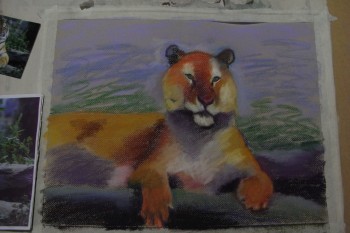Pastel Painting Techniques
Pastel Art Tutorials
Pastel Painting Techniques

We are over halfway and we have discovered a lot about the basics of painting with pastels.
In this module, we are going to talk about some of the main techniques that you can use.
There are three techniques that are very commonly employed in pastel painting, all of which are worth learning; if only so that you can play around with them and come up with your own variations.
Blending
Blending simply means rubbing and combining two adjacent areas of colour into one another. It’s one of the most commonly used techniques in pastel painting.
Unlike oil and acrylic paint, with pastels the only way to mix colours is to blend them together, once they have already been applied to the paper. This mixing is done to create variations of colour, tone and for shading.
Scrumbling
Scrumbling is an odd name, given to the technique of lightly dragging the side of a soft pastel over a layer of pastel of another colour that has already been laid down on the surface.
This results in a ‘broken’ or ‘grainy’ covering of the new colour over the old and it gives a textural, uncontrolled, ‘painterly’ effect. This technique has many creative applications.
It could be used to indicate atmospheric haze, to render some long grass in the foreground of a landscape, or to help create a soft complexion (for example a child’s face) in a portrait.
Hatching
Hatching is simply drawing a series of fine, parallel (straight or curved) lines on the surface.
When painting with pastels this is best done with a hard pastel stick or a pastel pencil, as these will make better and finer lines than soft pastels.
Hatching is usually used for shading. The thickness and spacing of the lines will affect how dark or light that area of the surface appears.
These techniques will start you off and as we said at the beginning, they are just the basics.
Other techniques are;
- Feathering
- Pointillism
- Dusting
- Glazing
- Side Stroke
You can read the book ‘Pastel Painting Secrets’ for a more in-depth look at these techniques, as there are several illustrations. It’s certainly good to ‘see’ what each one is supposed to look like.
In the ‘Step by Step’ books, the artist uses these three techniques, which really are the basics of pastel painting.
You can grab a copy of one or all the books here.
In the next module we are going to look at the importance of value, something that you will need to know about if you want to create stunning art.
